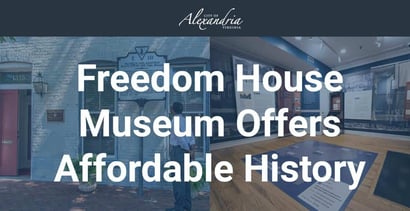
In a Nutshell: Antebellum U.S. slavery subjugated people on many levels, including relegating them to the status of property. Alexandria, Virginia’s Freedom House Museum acknowledges that reality as it honors the lives and experiences of thousands of Black men, women, and children treated as property in the slave trade. The museum is the City of Alexandria’s careful restoration of a former slave trading house, reminding Americans of their past and challenging them in the present. It offers an affordable and contemplative learning experience for individuals and families visiting Alexandria and nearby Washington, D.C.
The story of Alexandria, Virginia’s Freedom House Museum starts with a couple of businessmen and an idea. In 1828, Isaac Franklin and John Armfield leased a building at 1315 Duke Street in Alexandria to hold and trade enslaved people.
Like many of their peers, Franklin and Armfield observed the tobacco industry declining in Virginia and neighboring states due to soil depletion and market changes. The monetary value of the enslaved Black men, women, and children who worked the plantations also deteriorated.
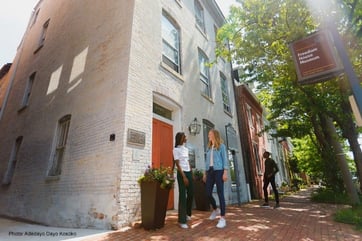
But the cotton and sugar industries in the southern Mississippi region boomed, and demand for slaves skyrocketed there. Franklin and Armfield set themselves up as brokers, purchasing enslaved people from tobacco plantations in the Chesapeake Bay area and shipping them by boat or forcing them to walk on foot to New Orleans and Natchez, Mississippi, where cotton and sugar planters waited to snap them up.
It was a profit-making slave trade machine. Franklin and Armfield used emerging shipping technology and the developing U.S. banking system to create the largest and most powerful domestic slave trading company in the U.S. The partners transported an estimated 10,000 people over their careers, and their business served as a blueprint for other interstate domestic slave trading companies.

It’s part of a 400-year tragedy of racial dehumanization that scourges American society to this day. The exhibits at Freedom House Museum encourage visitors to understand what happened there and how it impacted the people held there.
That makes Freedom House Museum a must-see for visitors to Alexandria and neighboring Washington, D.C. Donations are encouraged, but there’s no entrance fee. Due to the sensitive nature of the content, Freedom House Museum is recommended for visitors aged 8 and above. It offers adult and family travelers a contemplative, affordable respite for learning, reflection, and connection.
“This is a difficult history that evokes strong feelings,” said Dan Lee, Ph.D., City Historian of Alexandria. “Freedom House Museum is a reminder and a remembrance for the people who passed through to other places.”
Three Floors of Exhibits Engage Visitors
Thousands of people passed through those doors on their way to be sold in the Southern U.S. in the 1800s. Franklin and Armfield got rich as slave brokers, cashing out in 1836-37 for a life as planters.
Smaller slave trading firms used the Duke Street property until the Union army occupied Alexandria in 1861. After the Civil War, the property had various uses and took many forms until the city purchased it in 2020.
“We’ve completed a Historic Structures Report and have a pretty good idea of what it looked like,” Lee said. “The original office building still stands, and that’s where the museum is.”
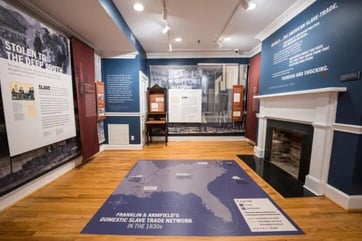
Exhibits on the building’s three floors immerse visitors. On the first floor, “1315 Duke Street,” the keystone exhibition, narrates stories of the people who moved through the property. The exhibit presents personal experiences of trafficked individuals, archaeological artifacts, and a model of the complex.
On the second floor is “Determined: The 400-Year Struggle for Black Equality,” a traveling exhibition from the Virginia Museum of History and Culture that takes a broad view of Black history in Virginia. It presents stories of individuals who struggled for justice over four centuries. The “Determined in Alexandria” exhibition includes paintings of notable African Americans in Alexandria by students from Northern Virginia Community College.
The third floor presents paintings of African American sites by the late local artist Sherry Z. Sanabria. Visitors also use the third floor to record their responses to the exhibits.
“We have space for people to reflect and write down their thoughts and feelings,” Lee said. “In that way, we offer a more interactive experience than older museums used to have.”
A Sojourn for Travelers to the D.C. Area
Freedom House Museum has also hosted a temporary exhibit by students of Virginia Theological Seminary about enslaved people on that school’s property. Lee said Alexandria residents have a say in the displays and are welcome to uncover history relevant to them or that touches their lives.
Freedom House Museum is in a relatively out-of-the-way location away from downtown. That makes it an intentional visit for travelers to the area, many of whom lodge in the city as a lower-cost alternative to D.C. hotels.
“Duke Street was in a thriving business district long ago,” Lee said. “Businesses have returned, but most of our museums are closer to the waterfront along King Street.”
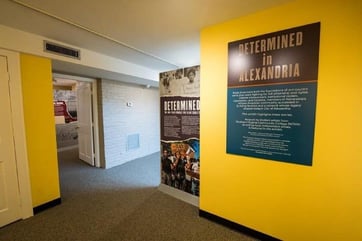
Freedom House Museum sees a slight upsurge in the number of visitors during Black History Month in February, but attendance rates are consistent throughout the year. Students from area schools come to learn about Virginia’s history. Out-of-towners discover the museum through research and publicity and seek out the specific experience it offers.
Alexandria is an affordable home base for D.C.-area visitors, and there’s much to see and do in the city. King Street and its environs comprise the city’s commercial district. The lower cost of Alexandria’s attractions, restaurants, boutiques, and brewpubs lures budget-minded D.C.-area travelers.
Alexandria is an attraction in its own right. Downtown pops with activity. A water taxi on the Potomac River runs from the city to D.C.
History is never far away. George Washington resided in Alexandria and considered it his adopted hometown. Mount Vernon, Washington’s plantation home, is located eight miles to the south.
“It’s easy to visit Alexandria, sample the restaurants and boutiques, and stumble into our history,” Lee said. “We have a tavern museum and an apothecary museum downtown, but Freedom House Museum offers a weightier experience.”
Sparking Memories and Family Conversations
The historic commercial structure is also a work in progress. Freedom House Museum is an ongoing research and remembrance project.
The Northern Virginia Urban League occupied the property before the city purchased it in 2020. The city will eventually have to close the building for renovations. Installing an elevator and expanding the bathrooms made it ADA-compliant, but the original structure dates to about 1812-15.
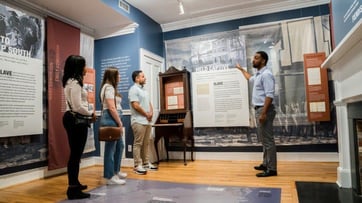
A large map on the surface of the museum’s first floor illustrates the reach of Franklin and Armfield’s business, explaining its nationwide scope. Lee said much of American society viewed the pair as groundbreaking entrepreneurs. Freedom House Museum acknowledges that while giving voice to the thousands of lives they affected.
Visitors occasionally shy away from walking on the map. Lee suggests that visitors get as close to the illustration as they want to understand the financial motivations of the slave trade.
Lee encourages families to visit. As the father of a 4-year-old, he often debates when he will consider exposing his child to the material. He’s proud that the museum thoroughly explains how we know what we know without guessing or approximating. But it’s not for everyone.
“I have been amazed and impressed by how I hear parents talk to their children about this,” Lee said. “It’s not something you should take lightly. I encourage parents to think carefully about how they want to communicate with their children about this subject.”
Ultimately, it’s worth it, Lee said.
“I’ve heard incredibly thoughtful conversations,” he said. “We have a wall with the names and ages of people who went through that building. Some were as young as the children who visit today.”






